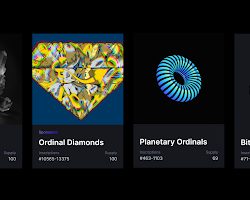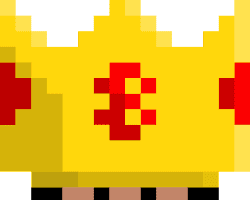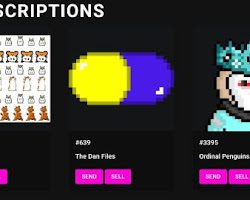Bitcoin NFTs: Ordinals Inscriptions Explained (Finding, Buying, and More)

Bitcoin NFTs, or Bitcoin non-fungible tokens, are unique digital assets built on the Bitcoin blockchain. They combine the characteristics of both Bitcoin and non-fungible tokens (NFTs), creating a new form of digital ownership and collectibles within the Bitcoin ecosystem.
To understand Bitcoin NFTs, it’s important to grasp the concepts of Bitcoin and NFTs individually. Bitcoin is a decentralized digital currency that operates on a peer-to-peer network known as the blockchain. It is fungible, meaning each Bitcoin is interchangeable with another Bitcoin, and they have the same value and properties. Bitcoin transactions are recorded on the blockchain, ensuring transparency and immutability.
On the other hand, non-fungible tokens (NFTs) are unique digital assets that represent ownership or proof of authenticity for a particular item, whether it’s artwork, music, videos, virtual real estate, or even virtual goods within video games. NFTs are built on various blockchain platforms, such as Ethereum, and they use smart contracts to establish ownership and enable the transfer of these unique digital assets.
Bitcoin NFTs take advantage of the Bitcoin blockchain’s security, scalability, and robustness while incorporating the concept of non-fungible tokens. By utilizing layer-two solutions like the Lightning Network or sidechains, developers have found ways to implement NFT functionality on top of the Bitcoin network.
Bitcoin NFTs have several benefits and implications. Firstly, they enable the ownership and trading of unique digital assets directly within the Bitcoin ecosystem. Previously, NFTs were primarily associated with Ethereum and other blockchain platforms, but Bitcoin NFTs allow for the expansion of the NFT market to the largest and most established cryptocurrency.
Another advantage is the security provided by the Bitcoin blockchain. As one of the most secure and resilient blockchains, Bitcoin ensures the immutability of ownership records and protects against fraud or tampering. This enhances the trustworthiness and authenticity of Bitcoin NFTs.
Bitcoin NFTs can also leverage the vast user base and liquidity of the Bitcoin network. The broad adoption and global recognition of Bitcoin provide a wider audience for NFT creators and collectors. Additionally, the high liquidity of Bitcoin allows for easier trading and liquidity of Bitcoin NFTs, potentially creating a more active and vibrant market.
However, it’s worth noting that Bitcoin’s scripting language is less expressive compared to Ethereum’s, which has been the primary blockchain for NFT development. Bitcoin NFTs may have certain limitations in terms of programmability and the complexity of smart contracts. Nevertheless, developers have been exploring innovative solutions to overcome these challenges and expand the capabilities of Bitcoin NFTs.
In conclusion, Bitcoin NFTs represent a fusion of Bitcoin’s monetary characteristics and the uniqueness of non-fungible tokens. They introduce a new dimension to the Bitcoin ecosystem, enabling the ownership, trading, and collection of unique digital assets within the secure and established Bitcoin blockchain. As the technology evolves, Bitcoin NFTs have the potential to reshape the digital collectibles market and create exciting opportunities for creators, collectors, and enthusiasts within the Bitcoin community.
Also read: Your Ultimate Guide To Bitcoin Ordinals And NFTs
How do ordinal inscriptions work?
Ordinal inscriptions are a system of marking or numbering objects or events according to their position in a sequence or order. Unlike cardinal numbers that represent quantity or value (e.g., “one,” “two,” “three”), ordinal numbers indicate the relative position or rank of an item within a series (e.g., “first,” “second,” “third”).
The primary function of ordinal inscriptions is to provide a clear and unambiguous way to express the sequential order of objects or events. They are used in various contexts and applications, including mathematics, linguistics, sports, rankings, contests, competitions, and many other areas where order and hierarchy are important.
In written form, ordinal inscriptions typically take the form of adjectives or adverbs that modify or describe the noun or verb they relate to. For example, “first place,” “second round,” “third chapter,” “fourth anniversary.” They can also be represented using abbreviations, such as 1st, 2nd, 3rd, 4th, and so on.
In terms of pronunciation, ordinal inscriptions often follow regular patterns. For example, most ordinal numbers ending in “th” are pronounced by adding the sound “th” to the cardinal number (e.g., “fifth” pronounced as “fif-th,” “tenth” pronounced as “ten-th”). However, there are some irregularities in English, such as the pronunciation of “first” and “second.”
Ordinal inscriptions can be applied to a wide range of scenarios. In sports, for instance, they are used to denote the ranking or position of teams or individuals in a competition. In academic settings, they indicate the order of classes or academic years (e.g., “first grade,” “second semester”). In literature or storytelling, they help to structure and organize narratives by dividing them into chapters or sections (e.g., “Chapter 1,” “Part III”).
The use of ordinal inscriptions has also found its way into digital and computational systems. In programming, ordinal numbers can be represented by numerical values (e.g., 1, 2, 3) and used to access elements in ordered lists or arrays. Additionally, in data analysis or database management, ordinal variables are used to categorize data with a defined order or ranking (e.g., “low,” “medium,” “high”).
It’s important to note that ordinal inscriptions can differ across languages. While the English language commonly uses terms like “first,” “second,” “third,” other languages may have their own unique set of words or grammatical structures to represent ordinal numbers.
In summary, ordinal inscriptions provide a way to express the order or ranking of objects, events, or concepts within a sequence. They serve as a valuable tool for organizing, categorizing, and communicating information in a clear and structured manner. Whether in written or spoken form, ordinal inscriptions play a fundamental role in various fields and everyday contexts, contributing to the efficient understanding and interpretation of sequential data.
Also read: Bitcoin Ordinals Community Debates Resolution For Inscription Validation Bug
Top 10 Notable Ordinals Inscriptions
Ordinal inscriptions are a new type of non-fungible token (NFT) that can be created on the Bitcoin blockchain. They are created by inscribing data, such as images, videos, or text, onto individual satoshis, the smallest unit of bitcoin.
Ordinal inscriptions have been gaining popularity in recent months, and there are now a number of notable examples of this new technology. Here are the top 10 most notable ordinal inscriptions:
- Ordinal Punks
Ordinal Punks is a collection of 100 NFTs that are inspired by the popular CryptoPunks project. Each Ordinal Punk is a unique satoshi that has been inscribed with a different image of a punk. 
- Taproot Wizards
Taproot Wizards is a collection of 100 NFTs that celebrate the Taproot upgrade to the Bitcoin protocol. Each Taproot Wizard is a unique satoshi that has been inscribed with a different image of a wizard.
- Bitcoin Rocks
Bitcoin Rocks is a collection of 100 NFTs that are each a unique satoshi that has been inscribed with a different image of a rock. 
- Timechain Collectibles
Timechain Collectibles is a collection of 100 NFTs that each represent a different day in history. Each NFT is a unique satoshi that has been inscribed with an image and a brief description of the event that occurred on that day.
- Ordinal Loops
Ordinal Loops is a collection of 100 NFTs that are each a unique satoshi that has been inscribed with a different animated loop. 
- Ripcache’s Power Source
Ripcache’s Power Source is a unique NFT that represents the power source for the Bitcoin network. The NFT is a unique satoshi that has been inscribed with an image of a lightning bolt and a brief description of how lightning can be used to power the Bitcoin network.
- Bitcoin Shrooms
Bitcoin Shrooms is a collection of 100 NFTs that are each a unique satoshi that has been inscribed with a different image of a mushroom. 
- The Shadow Hats
The Shadow Hats is a collection of 100 NFTs that are each a unique satoshi that has been inscribed with a different image of a shadow hat.
- The Dan Files
The Dan Files is a collection of 100 NFTs that are each a unique satoshi that has been inscribed with a different image of a file. The files represent different pieces of data that are important to the Bitcoin community. 
- Torus
Torus is a unique NFT that represents the Torus network, a decentralized protocol for connecting bitcoin wallets to other blockchains. The NFT is a unique satoshi that has been inscribed with an image of a torus and a brief description of the Torus network.
These are just a few of the many notable ordinal inscriptions that have been created. As this new technology continues to develop, we can expect to see even more creative and innovative examples of ordinal inscriptions in the future.
Benefits of Bitcoin NFTs
Bitcoin NFTs (non-fungible tokens) offer several benefits that arise from the combination of the unique characteristics of Bitcoin and the functionality of NFTs. Here are some of the advantages of Bitcoin NFTs:
1. Security and Immunity: Bitcoin is built on a highly secure and resilient blockchain network. By leveraging the Bitcoin blockchain for NFTs, creators and collectors benefit from the robust security and immutability of the Bitcoin network. Transactions and ownership records are stored on a decentralized ledger, making it extremely difficult for unauthorized modifications or fraudulent activities to occur.
2. Broad User Base and Liquidity: Bitcoin has a large and global user base, which provides a significant advantage for Bitcoin NFTs. By integrating NFT functionality into the Bitcoin ecosystem, NFT creators and collectors gain access to a vast community of users who are already familiar with Bitcoin. This broader audience can lead to increased exposure, engagement, and potential value for Bitcoin NFTs. Additionally, the high liquidity of Bitcoin allows for easier trading and enhanced market dynamics.
3. Network Effects: Bitcoin is the most established and recognized cryptocurrency. By incorporating NFT functionality into the Bitcoin ecosystem, it benefits from the network effects and infrastructure already in place. This includes the existing wallet infrastructure, exchange support, custody solutions, and developer tools that have been built around Bitcoin. Leveraging this infrastructure can help streamline the adoption and integration of Bitcoin NFTs into various platforms and services.
4. Store of Value: Bitcoin is often referred to as a digital store of value or “digital gold” due to its limited supply and scarcity. By combining NFTs with Bitcoin, creators can potentially enhance the value proposition of their digital assets. Bitcoin’s reputation as a store of value can attract investors and collectors who may see the combination of Bitcoin’s monetary properties and the uniqueness of NFTs as an appealing investment opportunity.
5. Interoperability and Cross-Chain Capabilities: While NFTs are predominantly associated with blockchain platforms like Ethereum, the emergence of cross-chain solutions and layer-two protocols allows for interoperability between different blockchains. This means that Bitcoin NFTs can be made compatible with other blockchain ecosystems, enabling seamless interaction and interoperability between Bitcoin NFTs and NFTs on other platforms. This cross-chain compatibility expands the possibilities for NFT creators and collectors and creates a more connected and vibrant NFT ecosystem.
6. Expanded Use Cases: Bitcoin NFTs offer new avenues for creativity and innovation within the Bitcoin ecosystem. Artists, musicians, content creators, and developers can leverage Bitcoin NFTs to tokenize their work, establish ownership rights, and monetize their creations directly within the Bitcoin network. This expands the use cases of Bitcoin beyond its traditional role as a digital currency, providing a platform for digital collectibles, virtual assets, and unique digital experiences.
It’s important to note that Bitcoin’s scripting language is less expressive compared to platforms like Ethereum, which has been the primary blockchain for NFT development. This limitation may affect the programmability and complexity of smart contracts associated with Bitcoin NFTs. However, developers continue to explore solutions and innovations to overcome these challenges and expand the capabilities of Bitcoin NFTs.
In summary, the benefits of Bitcoin NFTs include the security and immutability of the Bitcoin blockchain, the broad user base and liquidity of Bitcoin, the network effects and infrastructure already in place, the store of value properties of Bitcoin, interoperability and cross-chain capabilities, and the expansion of use cases within the Bitcoin ecosystem. These advantages provide exciting opportunities for creators, collectors, and enthusiasts to explore and participate in the emerging world of Bitcoin NFTs.
Where can you find Bitcoin NFTs and How do you know if a Bitcoin NFT is legitimate
Finding Bitcoin NFTs can be done through various platforms and marketplaces that support the creation, sale, and trading of NFTs on the Bitcoin blockchain. Here are a few places where you can find Bitcoin NFTs:
1. Rarible (rarible.com): Rarible is a popular decentralized marketplace for NFTs that has expanded its support to the Bitcoin blockchain. It allows creators to mint and sell their Bitcoin NFTs directly on the platform.
2. Mintable (mintable.app): Mintable is another platform that enables the creation and sale of NFTs, including those on the Bitcoin blockchain. It provides an accessible marketplace for creators and collectors to engage with Bitcoin NFTs.
3. OpenSea (opensea.io): OpenSea, one of the largest NFT marketplaces, has started supporting Bitcoin NFTs in addition to its Ethereum-based offerings. It provides a wide range of NFTs, including art, collectibles, virtual real estate, and more.
4. Nifty Gateway (niftygateway.com): Nifty Gateway, owned by Gemini, is a curated marketplace that offers a selection of NFTs, including those on the Bitcoin blockchain. It collaborates with artists and creators to bring their unique digital assets to the market.
5. Other Marketplaces: Various other platforms and marketplaces are exploring or already supporting Bitcoin NFTs. As the ecosystem evolves, new platforms may emerge, providing additional avenues for finding and engaging with Bitcoin NFTs.
When considering the legitimacy of a Bitcoin NFT, it’s essential to verify its authenticity and ownership. Here are some factors to consider:
1. Blockchain Confirmation: One of the key features of NFTs is their existence and immutability on the blockchain. You can verify the legitimacy of a Bitcoin NFT by checking its transaction history on the Bitcoin blockchain. Each transaction and ownership transfer should be recorded on the blockchain, providing transparency and evidence of the token’s legitimacy.
2. Metadata and Creator Verification: Bitcoin NFTs often include metadata, such as information about the creator, description, artwork, or associated content. Verifying the accuracy and consistency of this metadata can help ensure the legitimacy of the NFT. Checking the reputation and authenticity of the creator or artist can also provide assurance.
3. Platform Reputation: Choosing reputable and well-established platforms and marketplaces can reduce the risk of encountering illegitimate Bitcoin NFTs. Platforms with strong community trust, robust security measures, and active moderation tend to prioritize the legitimacy of NFT listings.
4. Community Feedback: Engaging with the community and seeking feedback can be valuable when assessing the legitimacy of Bitcoin NFTs. Online forums, social media platforms, and communities dedicated to NFT discussions can provide insights, reviews, and warnings about potential scams or fraudulent activities.
5. Certificates of Authenticity: Some Bitcoin NFTs may be accompanied by certificates of authenticity or other forms of verification. These certificates, issued by reputable entities or organizations, can add an extra layer of legitimacy to the NFT.
6. Due Diligence: Conducting thorough research, reading reviews, and educating yourself about the particular Bitcoin NFT and the market it operates in can help you make informed decisions. Taking the time to understand the details of the NFT and assessing its legitimacy can mitigate the risk of falling victim to scams or counterfeit NFTs.
It’s important to note that while these factors can assist in determining the legitimacy of a Bitcoin NFT, there is always a possibility of fraudulent activity or misrepresentation. Staying vigilant, conducting your own research, and relying on trusted platforms and marketplaces can help mitigate risks in the evolving Bitcoin NFT space.



























































